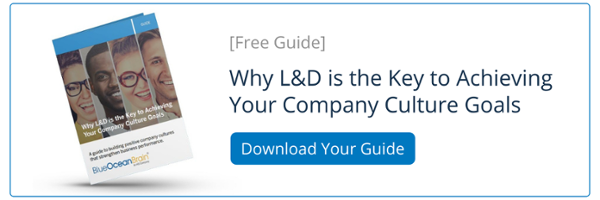Background
The Pandemic's Spotlight on Company Culture
The pandemic will forever change the way we work and what companies expect of employees. With the shift to remote work, many organizations realized their culture needs improvement to survive this tumultuous time. In a new survey, 38% of working professionals stated they would quit their job without another opportunity lined up - the main reason being a poor company culture.
At the same time, more than one-third say that no counteroffer would convince them to stay. For leaders, it is a sign that the Great Resignation is not showing signs of slowing down. One key to attracting top talent is a renewed focus on company culture. Businesses that succeed will rethink employee engagement and develop an employee-centric work environment.
According to a Society for Human Resource Management (SHRM) report, how well your workforce is handling the COVID-19 pandemic has a lot to do with its culture. That is because a strong company culture creates resilient teams.
SHRM's CEO Johnny C. Taylor noted:
"In the past year, we saw major shifts in organizational structures as employers sought to accommodate and support employees who were suddenly working in remote, hybrid or vastly different in-person environments.
The pandemic has certainly changed where and how we work, leaving it up to business leaders and HR professionals to create more seamless threads of positive culture that boost employee satisfaction and productivity."
The pandemic taught many businesses the importance of having a solid company culture and adapting it when things get tough. An adaptive culture provides the groundwork for transformation and innovation.

Company Culture's Influence on Burnout and Performance
Employers also recognized that positive company cultures help maintain employee engagement and performance while supporting an increasingly burned-out workforce. Unfortunately, burnout at work is a culture threat, and it worsened during the pandemic. A survey from Indeed found that more than half of workers (52%) feel burned out, and more than two-thirds (67%) believe the feeling has worsened throughout the pandemic. That is why more companies are moving from a burnout culture to a wellness culture.
In addition, a company focused on culture sets the stage for transformation. A recent survey by Boston Consulting Group found that organizations with a strong culture focus were five times more likely to achieve breakthrough performance than those that ignore it. And there is a clear correlation between corporate culture and financial performance. According to Forbes, companies with strong cultures have seen a 4x increase in revenue growth. Not only that, but organizations appearing on Fortune’s annual 100 Best Companies to Work For list also see higher average annual returns, with cumulative returns as high as 495% instead of 170% (Russell 3000) and 156% (S&P 500).

Intentional or not, you have a company culture.
Whether you acknowledge it or not, you have a company culture. The question is, is it intentional? When organizations fail to prioritize company culture, they risk more than just losing valuable talent. A toxic culture can put your reputation to the test. Recently, the CEO of Better.com brought his company’s culture into the public eye by announcing 900 layoffs over Zoom. He has since apologized, but the press coverage prompted a third-party investigation into the overall work environment, which revealed that the CEO’s behavior was reflective of a poorly evolved culture.
And let’s not forget Uber. Uber’s focus on aggressive growth, failure to prioritize compliance, and lack of transparency internally resulted in siloed teams that lacked coordination. Allegations of sexual harassment and gender discrimination further emphasized how toxic the culture was. These events led Uber to hire Bo Young Lee, its first-ever diversity and inclusion officer, to diversify its workforce, improve its culture, and build out its management team.
On the flip side, you have progressive companies like Spanx—a firm known for cultivating a strong culture based on fun and creativity. In fact, “Culture eats strategy for breakfast” is one of Spanx founder Sara Blakely's favorite quotes. Blakely was recently in the news for surprising each employee with a $10,000 bonus plus two first-class tickets anywhere in the world to celebrate the sale and partnership with global investment firm Blackstone.
Spanx understands that culture matters and has implications for the bottom line. Great company culture can create a work environment that encourages team building and employee engagement and helps retain top talent. In the long run, you are in a position for better business success.

Progressive Companies Focus on DEI and Their People
Progressive companies have goals around diversity, equity, and inclusion (DEI), employee growth and well-being, and shared values. Culture goals around DEI, employee growth, and well-being are not just altruistic. They lead to attracting the highest quality candidates, improving engagement, reducing turnover, and increasing productivity—all during a time when turnover is at an all-time high. In November 2021 alone, Americans quit their jobs at a record pace as job openings hovered close to their all-time highs. The number of workers quitting jobs jumped to 4.5 million from 4.2 million, meaning that 3% of workers voluntarily left their positions.
But what is culture? Company culture has many dimensions, including symbols, norms, practices, rituals, and beliefs. But at the heart of culture are core values. Core values are the clearly stated principles of the company’s mission and vision that unite employees around a guiding philosophy to achieve business goals. But ensuring that everyone understands values and culture is not easy. It requires hard work and exceptional internal communication.

Company culture goals are notoriously difficult to achieve.
Maintaining a positive company culture takes a lot more than just posting a mission statement on your website or the break room wall. Building a unified culture takes consistency, hard work, and dedication. You must periodically measure progress, monitor behavior and actions, and tweak programs accordingly to steer the organization successfully ahead.
But who is responsible for cultivating organizational culture? Traditionally, the HR team works to achieve company culture goals. In fact, according to a 2019 study conducted by HR Dive, when asked, “Which department is responsible for building, monitoring and enhancing company culture?” respondents overwhelmingly indicated that the HR department owns culture (52%), followed by the executive team (28%).
Before the pandemic, many businesses defined culture as free lunches, a beer fridge, and ping pong tables. But those are perks, not culture. Perks don't establish core values that drive the business. They also don't teach employees the interpersonal, communication, and conflict resolution skills needed to navigate the new normal in business. But you have a secret weapon that you may not be aware of—your learning ecosystem.
Your Learning Ecosystem is your secret weapon.
According to research by Bersin & Associates, organizations with a robust learning culture have:
- 37% more productive employees
- A 32% higher chance of being the first to market an innovative solution
- A 26% increase in their ability to deliver quality products
Your learning ecosystem can be more than just a set of learning tools, such as a learning management system (LMS) or learning experience platform (LXP). It can be a source of community, engagement, culture, and rich learning experiences. But you can't build a strong corporate culture overnight. That's why your learning ecosystem needs to be scalable and easy to access.
Employees aren't going to make an effort to learn if the process isn't seamless. Whether through an LMS, LXP, intranet, etc., delivering courses must be a user-friendly and intuitive experience. Ideally, you should have on-demand learning that enables your teams to access course materials anywhere at any time via smartphone or tablet. This feature is vital so that today's remote and hybrid workforces can quickly learn on the go and in the flow of work. The good news is, if your learning ecosystem is already in place—all you need now is the right content!

Add the right content to fuel your company culture goals.
According to research by McKinsey, L&D’s strategic role in the organization spans five areas:
- Develop people capabilities: Companies that make investments in future leaders see impressive returns. According to McKinsey:
"Companies in the top quartile of leadership outperform other organizations by nearly two times on earnings before interest, taxes, depreciation, and amortization (EBITDA). ...Companies that invest in developing leaders during significant transformations are 2.4 times more likely to hit their performance targets."
- Attract and Retain Talent: Opportunities for learning and growth are among the top reasons people join a company. On the flip side, a lack of growth opportunities is one of the key reasons workers cite for leaving an organization.
- Motivate and engage employees: To consistently engage employees, your organization must continue to invest in them. Proper training and development can significantly enhance employee engagement by nurturing talent and improving performance. When highly engaged employees have the skills to grow, they are more likely to be energized and satisfied with their organization.
- Build Your Employment Brand: Given the current situation, companies are working harder to compete for top talent. Investments in L&D can help enhance your brand and boost your reputation as an employer of choice.
- Create a values-based culture: As the workforce becomes more dispersed, L&D can help build a culture based on values and a sense of community. Education about values-based leadership should reinforce how to model desired behavior, encourage reflection among employees, and deal honestly and openly with ethical issues as they arise in the workplace.

Content That Resonates
Accessibility and relevance are crucial to creating memorable educational experiences, improving engagement, and increasing ROI from training initiatives. Unfortunately, most learning content lacks the approachable, inspirational tone needed to encourage shifts in thinking and behavior. That's because the standard one-size-fits-all approach is ineffective and outdated. Ideally, your content balances business objectives and addresses the needs of both people leaders and individual contributors.
Your L&D strategy should focus not just on general technical skills needed for your organization but also on developing learning paths that build the soft skills necessary to succeed in today's workplace. Emotional intelligence, inclusion and belonging, adaptability, and resilience are important. Offer flexible options that give employees a "choose your own adventure" experience so they can easily find the content that aligns with their learning style and professional development goals.
Personalized learning content should also be current and relevant. When employees take courses that apply to their role and skill level, their engagement and retention improve. Your L&D strategy should guide employees on a path that builds the skills necessary to embrace change and learn about the values surrounding your newly defined company culture.
Content With Choice
Offering multiple formats and delivery methods—like learning on the go—is one of the best and most convenient ways to engage employees. This mobile approach also gives employees ownership over their learning journey. Providing choices helps you increase engagement and enthusiasm for professional development.

Now, put it on repeat
Here’s a fun fact. Humans have a shorter attention span than that of a goldfish! A recent study found that the average human attention span has fallen from 12 seconds in 2000 to eight seconds today. Yet, the importance of learning in the workplace hasn’t diminished. A company culture of learning can make your organization more innovative and adaptable. But how can employees absorb large amounts of information with such short attention spans? The solution is microlearning.
According to the Association for Talent Development:
“Microlearning enhances learning and performance in the most efficient and effective manner possible through short pieces of content.”
Microlearning is particularly effective because it can be accessed on-demand while your employees are on the go, working remotely, or performing their job. Each microlearning segment builds on concepts through bite-sized chunks of content. You can think of them as learning snacks delivered via text, images, audio, video, quizzes, podcasts, or even interactive games.
With drip learning, you can deliver smaller bits of content over time. That way, you keep learning easily digestible. This approach also allows you to address questions between lessons and review how employees retain and apply the information. Learners can process information before tackling the next one with a break between courses.
Microcontent is not just traditional lessons chopped up - it is skillfully designed and structured for microlearning. For example, imagine creating a course on unconscious bias. Lesson one builds awareness around what it is and why all humans have it. Then lesson two dives into how it impacts the workplace; finally, lesson three addresses identifying and avoiding it in our day-to-day professional lives. Drip learning is also instrumental with new hire training, where most employees feel like they are drinking from a firehose. With microlearning, you can turn the firehose into a fountain.Creating learning and development content is hard!
Microlearning has many benefits, including increasing employee engagement and improving knowledge retention. But it can take time and effort to maintain. One way to address this is to empower more people within your organization to create content. This approach, also called employee-generated learning, means giving subject matter experts the authority to develop and maintain valuable learning materials. It harnesses their expertise and allows them to share it with colleagues.
Things are constantly changing.
Another challenge in creating content is that change is a constant in today’s aggressive, fast-moving business environment. And as the business landscape changes, your microlearning content will need to change along with it. That will require your organization to remain agile and ready to pivot as needed. For example, as stress and anxiety have increased during the pandemic, more companies recognize the importance of incorporating learning resources on resilience, mindfulness, burnout and adapting to change. And let’s not forget the renewed focus on DEI initiatives as companies recognize the business imperative and benefits of bringing together diverse thoughts, perspectives, and backgrounds.
It's complicated
Another hurdle to creating content is that the material needs can vary across the organization. For example, you may want leadership content customized to managers leading growing teams and more advanced materials targeted to employee resource groups and cultural ambassadors. You will successfully increase engagement and productivity by providing personalized training paths for employees.
But to remain flexible and deliver personalized learning content, you also need a robust library of rich content across a broad and deep range of topics. Creating that much information can be time-consuming to develop and difficult to maintain. For that reason, many companies choose to partner with a firm that offers off-the-shelf or customized learning content so you can meet your L&D goals, engage employees, and drive your business forward.
What does a content partner look like?
Blue Ocean Brain is one such partner. Blue Ocean Brain delivers world-class learning to corporate clients through a library of over 5,000 microlearning assets and fresh new content published daily. Whether it's training around soft skills, leadership development, or DEI, Blue Ocean Brain has content to align with your company's unique mission, strategy, and culture goals.
An example of Blue Ocean Brain in practice is with clients who roll out the platform to their employees with learning journeys to promote diversity, inclusion, and hybrid team success. Lessons delivered to their employees include actionable takeaways on building inclusion among remote teams and boosting employee well-being during times of uncertainty. Other clients use our leadership briefs, live webcasts, and library scavenger hunts to bring employees together in collaboration, encouraging the camaraderie of remote teams.
And the best part—you can leverage our engaging platform or inject our award-winning content into your learning ecosystem. Either way, your people can enjoy seamless, relevant, and inclusive microlearning crafted how the brain learns best—one lesson at a time.
Building a strong corporate culture does not happen overnight. It requires innovative leadership and employee buy-in. But the L&D team can play a significant role so that you can get there much faster. Integrating learning into every aspect of work can inspire employees to join you on the journey to an improved culture.
Allowing employees to experiment, share experiences, and learn is essential to creating a culture where employees can take their professional development into their own hands. Culture change is a marathon, not a sprint. By being intentional about building and preserving it, you will succeed in achieving your organization's culture goals while attracting and retaining top talent.
